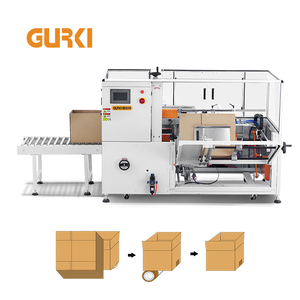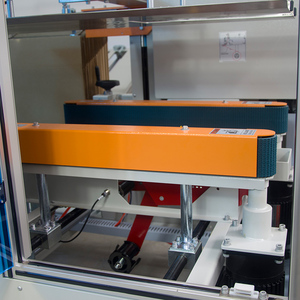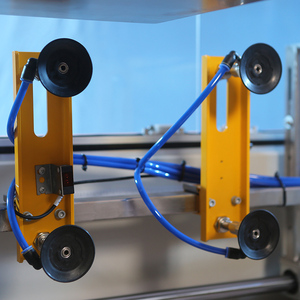
All categories
Featured selections
Trade Assurance
Buyer Central
Help Center
Get the app
Become a supplier

(4606 products available)



























A case erector is a device used to construct a carton or case from a flat-pack, called a carton erector. It is used predominantly in the packaging industry at a time where speed and efficiency are of the utmost importance in product delivery. This machine constructs a box from a flat piece of cardboard. It can be done automatically or semi-automatically. Once constructed, it will be filled with products and sealed, ready for product delivery.
The box erector machine works by taking the flat piece of cardboard from a hopper, which is then formed into a box or case by a molding device. This can be assisted with adhesive, which is applied by a gluing device, or tape, which is applied and sealed by a taping device. This process can be further accelerated by using a robotic arm to assist with sealing and tape application.
A semi-automated case erector is performed manually, where an operator will pick up the flat piece of cardboard from a hopper and perform the needed steps to seal and tape the box.
There are various types of box erectors that are used and categorized based on their level of automation, capacity, and the types of boxes they can erect:
These box erectors offer varying levels of automation and adaptation to suit different industry needs, production speeds, and product types. They are valuable tools for improving productivity, reducing labor costs, and ensuring consistent box formation in packaging operations.
The specifications of a case erector vary greatly depending on the type of machine and its model. However, the following specifications are common across the board.
Because of the complexity of the case erector machine, regular maintenance is imperative to ensuring optimal functioning and performance. The maintenance schedule is as follows:
Case erectors are useful in a variety of industrial applications. Here are some of them.
Food and Beverage
Packaging products such as cartons and boxes is a common practice in the food and beverage industry. Cased box erectors are used to create sturdy and hygienic boxes for multiple products. The boxes are also easy to open and dispose of, making them ideal for packaging for both manufacturers and consumers.
Cosmetics and Personal Care
Most personal care and cosmetic items come in carton and box packages. This includes the items themselves. Case erectors are commonly used to create cases for these items. This saves time and money during product preparation for sale. Additionally, fully automated case erectors increase productivity.
Pharmaceuticals
Pharmaceutical companies package their products in cases to provide information and ensure the product is safe. Case erectors are commonly used to create the packaging. The resulting cartons are easy to open and recycle, which is an added benefit for the environment.
Industrial Manufacturing
Case erectors are common in industrial manufacturing processes. Products such as tools, parts, and components are made in bulk and require strong packaging. Case erectors save time, labor, and money by quickly and efficiently creating cases for these products.
Electronics
Case erectors can be used to manufacture cases for electronic devices when a product requires protective packaging and easy opening. This is especially useful for large electronics such as TVs and computers. These are heavy, bulky products that need strong cases. Automated case erectors can create hundreds of cases in a short time with little or no supervision. This allows the manufacturer to divert resources to other areas of production and increase efficiency.
Retail
Case erectors are used to prepare products for sale at retail outlets. The cases are easy to stack on shelves and provide product visibility. The use of case erectors speeds up the packing process, so products can get to the store faster.
When buying a case erector machine for retail or industrial use, it is essential to consider features, performance, and other specifications so as to purchase a unit that meets one's unique needs.
Creation:
The main components of a case erector are feed belts, box-forming arms, product inserts, and case tapers. Investigate the quality and reliability of these parts to determine the overall performance of a machine. Reviewing user manuals is also an excellent way of understanding the construction of the erector.
Operations:
It is important to study the operating system of the case erector before buying it. A better understanding of a machine's production speed, automation, and box size will give buyers the confidence to choose a specific model for a particular task.
Technology:
Some models of case erectors come with advanced technologies that improve efficiency and precision. Examples include sensor-driven automation and customizable software interfaces. These kinds of technological features can influence a buyer's decision and are worth considering.
Maintenance:
Before buying a case erector, it is important to investigate the maintenance requirements of the machine. Some models have complicated maintenance needs, which might require additional costs and service expertise. Choosing a machine with easy maintenance and service assistance will go a long way in ensuring long-term satisfaction.
Adaptability:
A typical case erector has several adjustments and add-ons to ensure adaptability to different types and sizes of cases. When buying a case erector, consider models that can easily adapt to unique operational needs.
Safety:
Ensure that the machine's design meets safety standards. Such requirements will help protect operators and reduce liabilities.
Q1: How fast can a case erector work?
A1: Case erecting machines work at different speeds depending on the model and case size. Most case erecting machines can create anywhere from 30 to 180 cases per minute.
Q2: What are the most common types of cases used in a case erector?
A2: The most common type of case used with a case erector is a carton. Carton cases are widely used for products like books, toys, and food. Numerous other industries use them!
Q3: Can a case erector be integrated into existing production lines?
A3: Yes, because case erectors are versatile machinery, they can be integrated into existing production lines.
Q4: What maintenance requirements does a case erector have?
A4: The maintenance requirements of a case erector may differ depending on the machine's model and manufacturer's instructions. However, generally, regular inspections are required. This also includes cleaning, lubrication, and occasional repairs.